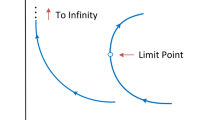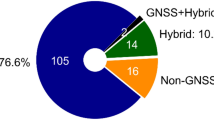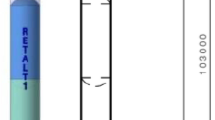Abstract
This paper deals with the optimization of the transfer trajectory of a solar sail-based spacecraft between circular and coplanar heliocentric orbits. The problem is addressed using both a direct and an indirect approach, while an ideal and an optical force model are used to describe the propulsive acceleration of a flat solar sail. In the direct approach, the total flight time is partitioned into arcs of equal duration, within which the sail attitude is assumed to be constant with respect to an orbital reference frame, and a nonlinear programming solver is used to optimize the transfer trajectory. The aim of the paper is to compare the performance of the two (direct and indirect) approaches in term of optimal (minimum) flight time. In this context, the simulation results show that a direct transcription method using a small number of arcs is sufficient to obtain a good estimate of the global minimum flight time obtained through the classical calculus of variation.
Similar content being viewed by others
Change history
11 February 2022
A Correction to this paper has been published: https://doi.org/10.1007/s42064-022-0136-2
Abbreviations
- a :
-
propulsive acceleration vector (mm/s2)
- a c :
-
characteristic acceleration (mm/s2)
- a r :
-
radial component of propulsive acceleration (mm/s2)
- a θ :
-
circumferential component of propulsive acceleration (mm/s2)
- a ⊕ :
-
gravitational acceleration at 1AU (mm/s2)
- b 1, b 2, b 3 :
-
sail force coefficients
- ê r :
-
radial unit vector
- ê θ :
-
circumferential unit vector
- \(\mathcal{H}\) :
-
Hamiltonian function
- i f :
-
inclination of the target orbit (deg)
- J :
-
performance index
- N :
-
number of arcs
- \(\hat{n}\) :
-
sail normal unit vector
- O :
-
Sun’s center of mass
- r :
-
Sun-spacecraft distance (AU)
- \(\mathcal{T}\)(O; r, θ):
-
polar reference frame
- ]t :
-
time (days)
- u :
-
radial component of spacecraft velocity (km/s)
- v :
-
circumferential component of spacecraft velocity (km/s)
- x :
-
state vector
- z :
-
nonlinear programming parameter vector
- α :
-
sail pitch angle (deg)
- α n :
-
sail cone angle (deg)
- β :
-
lightness number
- δ :
-
nonlinear equality constraints
- δn :
-
sail clock angle (deg)
- ε :
-
dimensionless error
- Δt :
-
flight time (days)
- θ :
-
polar angle (deg)
- λn, λθ, λu, λv :
-
adjoint variables
- μ⊙ :
-
Sun’s gravitational parameter (km3/s2)
- 0:
-
initial
- f:
-
final
- s:
-
initial guess
- *:
-
numerical result
- ~:
-
dimensionless
- ·:
-
time derivative
- d:
-
evaluated using direct approach
- i:
-
evaluated using indirect approach
References
Garwin, R. L. Solar sailing: a practical method of propulsion within the solar system. Journal of Jet Propulsion, 1958, 28(3): 188–190.
Tsu, T. C. Interplanetary travel by solar sail. ARS Journal, 1959, 29(6): 422–427.
Sauer, C. G. Jr. Optimum solar-sail interplanetary trajectories. In: Proceedings of the AIAA/AAS Astrodynamics Conference, 1976, DOI: https://doi.org/10.2514/6.1976-792.
Otten, M., McInnes, C. R. Near minimum-time trajectories for solar sails. Journal of Guidance, Control, and Dynamics, 2001, 24(3): 632–634.
Hughes, G. W., McInnes, C. R. Solar sail hybrid trajectory optimization for non-Keplerian orbit transfers. Journal of Guidance, Control, and Dynamics, 2002, 25(3): 602–604.
Betts, J. T. Survey of numerical methods for trajectory optimization. Journal of Guidance, Control, and Dynamics, 1998, 21(2): 193–207.
Conway, B. A. A survey of methods available for the numerical optimization of continuous dynamic systems. Journal of Optimization Theory and Applications, 2012, 152(2): 271–306.
Mengali, G., Quarta, A. A. Optimal three-dimensional interplanetary rendezvous using non-ideal solar sail. Journal of Guidance, Control, and Dynamics, 2005, 28(1): 173–177.
Mengali, G., Quarta, A. A. Solar sail trajectories with piecewise-constant steering laws. Aerospace Science and Technology, 2009, 13(8): 431–441.
Dachwald, B., Mengali, G., Quarta, A. A., Macdonald, M. Parametric model and optimal control of solar sails with optical degradation. Journal of Guidance, Control, and Dynamics, 2006, 29(5): 1170–1178.
Dachwald, B., Macdonald, M., McInnes, C. R., Mengali, G., Quarta, A. A. Impact of optical degradation on solar sail mission performance. Journal of Spacecraft and Rockets, 2007, 44(4): 740–749.
Mengali, G., Quarta, A. A., Circi, C., Dachwald, B. Refined solar sail force model with mission application. Journal of Guidance, Control, and Dynamics, 2007, 30(2): 512–520.
Wright, J. L. Space Sailing. Gordon and Breach, Philadelphia, 1992, 223–233.
McInnes, C. R. Solar Sailing: Technology, Dynamics and Mission Applications. Springer, 1999, 46–51.
Heaton, A. F., Artusio-Glimpse, A. B. An update to the NASA reference solar sail thrust model. In: Proceedings of AIAA SPACE 2015 Conference and Exposition, 2015, DOI: https://doi.org/10.2514/6.2015-4506.
Bryson, A. E. Jr., Ho, Y. C. Applied Optimal Control. Hemisphere Publishing Corporation, 1975, 71–89.
Stengel, R. F. Optimal Control and Estimation. Dover Publications, 1994, 222–254.
Lawden, D. F. Optimal Trajectories for Space Navigation. Butterworths, 1963, 54–60.
Niccolai, L., Quarta, A. A., Mengali, G. Analytical solution of the optimal steering law for non-ideal solar sail. Aerospace Science and Technology, 2017, 62: 11–18.
Shampine, L. F., Gordon, M. K. Computer Solution of Ordinary Differential Equations: The Initial Value Problem. W. H. Freeman, 1975.
Shampine, L. F., Reichelt, M. W. The MATLAB ODE suite. SIAM Journal on Scientific Computing, 1997, 18(1): 1–22.
Quarta, A. A., Mengali, G. Semi-analytical method for the analysis of solar sail heliocentric orbit raising. Journal of Guidance, Control, and Dynamics, 2012, 35(1): 330–335.
Author information
Authors and Affiliations
Corresponding author
Additional information
Andrea Caruso received his B.S. and M.S. degrees in aerospace engineering from University of Pisa, in 2013 and 2016, respectively. He is currently a Ph.D. student at the University of Pisa. His research interests are in spaceflight mechanics and spacecraft trajectory optimization.
Alessandro A. Quarta received his Ph.D. degree in aerospace engineering from the University of Pisa, in 2005, and is currently a professor of flight mechanics at the Department of Civil and Industrial Engineering of the University of Pisa. His main research areas include spaceflight simulation, spacecraft mission analysis and design, low-thrust trajectory optimization, solar sail and E-sail dynamics and control.
Giovanni Mengali received his Ph.D. degree in aeronautical engineering, in 1989, from the University of Pisa. Since 1990, he has been with the Department of Aerospace Engineering (now Department of Civil and Industrial Engineering) of the University of Pisa, first as a Ph.D student, then as an assistant and an associate professor. Currently, he is a professor of space flight mechanics. His main research areas include spacecraft mission analysis, trajectory optimization, solar sails, electric sails and aircraft flight dynamics and control.
Rights and permissions
About this article
Cite this article
Caruso, A., Quarta, A.A. & Mengali, G. Comparison between direct and indirect approach to solar sail circle-to-circle orbit raising optimization. Astrodyn 3, 273–284 (2019). https://doi.org/10.1007/s42064-019-0040-x
Received:
Accepted:
Published:
Issue Date:
DOI: https://doi.org/10.1007/s42064-019-0040-x




